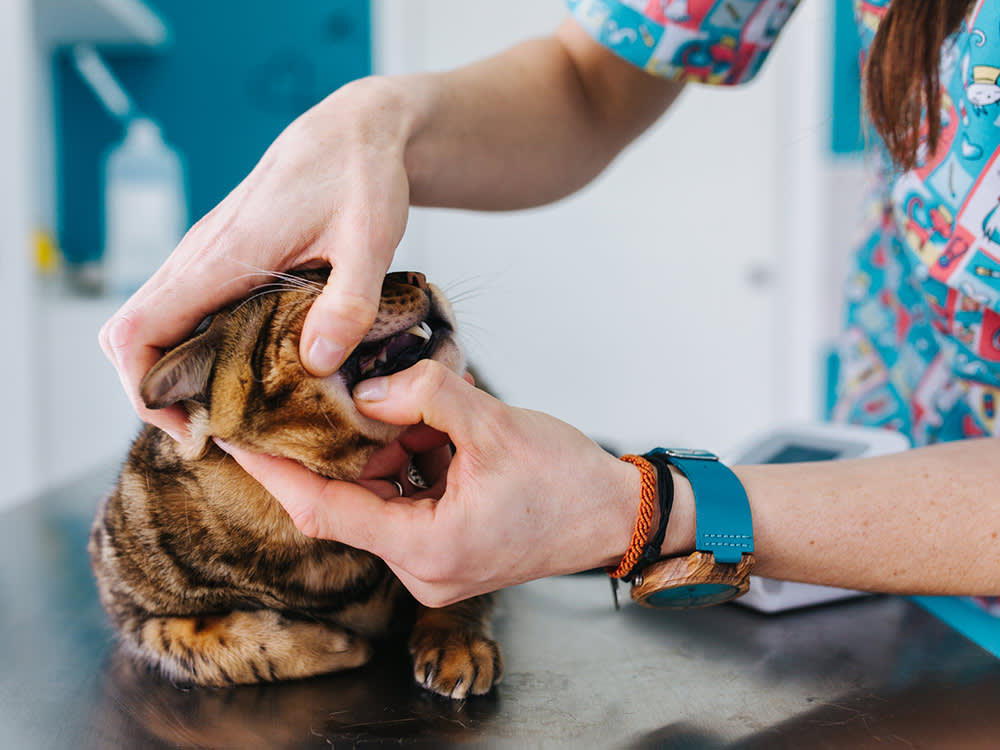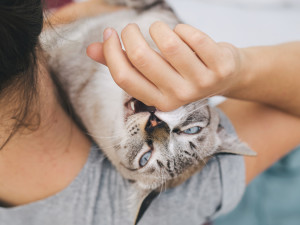What You Need to Know About Cat Mouth Ulcers
How to spot, diagnose, and treat these lesions — cancerous or non-cancerous.

Share Article
Most people don’t regularly poke around in their cat’s mouth (your cat really appreciates that, by the way.) But sometimes you might think it’s necessary to take a peek to see what’s going on beyond their chompers. There could be a sudden change in the smell of your cat’s breath or a weird spot you see when they yawn. Cats can develop ulcers in their mouths due to several different diseases. Oral ulcers may indicate a local problem, or they could be a sign of a systemic disease.
What are mouth ulcers, anyway?
An ulcer is any break in the skin or mucous membranes (like the gums, tongue, or cheeks) that results from the loss of normal tissue on the surface. This surface tissue can break down and develop a local area of necrosis (tissue death). The most common causes for ulcers in a cat’s mouth are dental disease, oral inflammation, and cancer.
What are the symptoms of mouth ulcers in cats?
Cats can show a variety of symptoms, depending on the severity, size, and location of the ulcer. They can experience dysphagia — or difficulty swallowing food. This can cause your cat to drop bits of food in or around the food bowl or to eat more slowly and carefully. Some cats who usually enjoy maintaining a shiny, healthy coat may develop an unkempt appearance if they are in pain when they’re trying to groom themselves. Some cats may show no symptoms at all; cats are great at keeping their problems hidden from us.
Signs of mouth ulcers in cats
Bad breath
Pawing at their mouth
Decreased or loss of appetite
Weight loss
It’s painful for your cat to eat
Drooling
Blood in the saliva
What are the common, non-cancerous causes of mouth ulcers in cats?
Problems related to dental disease are the most common cause of oral ulcers in cats. Cats can get inflamed, ulcerated gums, stemming from severe gingivitis caused by poor dental health. Sometimes, they can even get “kissing lesions,” when plaque-covered teeth contact the tongue or gums. A full dental evaluation and cleaning with continued oral health support at home can help to resolve these lesions.

Feline Caudal Stomatitis (FCS) causes inflammation and painful ulcers throughout a cat’s mouth. This disease can look similar to dental disease but extends beyond the tissues in contact with the teeth. Unfortunately, the cause for FCS is not fully understood. It may be caused by an inappropriate immune response to oral bacteria, viruses associated with upper respiratory infections, or Feline Leukemia Virus or Feline Immunodeficiency Virus (FeLV/FIV).
If viral testing does not show a cause, the best way to get FCS to resolve is to remove all (or most) of the teeth and some of the bone associated with them. This may seem very extreme, but it can save your cat a lifetime of chronic pain and dental problems. Cats who cannot have this surgery or cats who do not respond fully to surgery may need to be on drugs to suppress their immune system for life.
Other non-cancerous causes for oral ulcers are less common. Some cats can have an inappropriate allergic response and develop an eosinophilic granuloma (weirdly also known as a rodent ulcer). This appears as a large, raised, yellow-pink mass on the lip or in the mouth. Some of the nastier calicivirus infections can result in painful ulcers in the mouth in addition to upper respiratory symptoms. Licking caustic substances like household cleaners can cause ulcers on the tongue and gums. Some cats with very severe kidney disease will develop lesions in their mouth called uremic ulcers.
What are the common causes of cancerous mouth ulcers in cats?
Squamous cell carcinoma (SCC) is the most common oral tumor in cats and shows up in about 75 percent of felines having a growth investigated. These tumors often develop at the base of the tongue or gum margin, but SCC can be seen anywhere in the mouth. It usually appears as a large ulcerated mass. These tumors have a relatively high rate of spread to the lymph nodes or lungs. Sadly, difficulty eating, drinking, and breathing often worsens a cat’s quality of life before metastasis does.
Surgery gives the best chance at definitive treatment for SCC, but it should be approached with caution because the procedure can be extensive. Cats do not respond particularly well to surgeries involving removal of facial bones. They often require an extended recovery period with feeding tubes and supportive care after surgery. Overall, only less than 10 percent of cats survive a year after this diagnosis.
The other common cancer, fibrosarcoma, tends to cause less ulcerated, smooth masses in a cat’s mouth. This type of cancer still requires aggressive surgery, which involves removal of bone to resolve, but tends to have a better long-term prognosis.
What should you do about your cat’s mouth ulcers?
If you see an ulcer in your cat’s mouth or if your cat is showing symptoms of an ulcer, it’s best to contact your veterinarian to set up an appointment for an examination. Your veterinarian may need to sedate your kitty to examine their mouth fully and possibly take samples from any lesions noted. The treatment for the ulcers will vary based on the cause, but taking your cat to the vet gives them the best chance at getting back to their normal schedule of eating, grooming, and napping as soon as possible.

Dr. Bartley Harrison, DVM
Dr. Bartley Harrison is a veterinarian with more than 19 years of experience. He has treated a variety of species in emergency and speciality practices for both large and small animals. His primary interests as a vet are emergency medicine and critical care.
Related articles
![Cat sticking its tongue out in motion]()
Why Does My Cat Drool?
Dogs rule, cats drool. Like, that’s normal, right?
![cat biting person's hand]()
How to Make Your Cat’s Oral Care as Stress-Free as Possible
Your cat’s oral hygiene is essential to their health. Take things slow and figure out what works best for your kitty’s pearly whites.
![White Persian cat on a blue background]()
UTIs Suck for Your Cat, Too
Here’s how to help them get relief.
![Brown Gray Cat Lounging on Red Arm Chair Near Green Plant]()
What to Know About Hyperthyroidism in Cats
Everything you need to know about the common disease.
Your Cat Is Limping. Now What?
When it’s no big deal and when you should worry.
![A senior cat is held in their owner's lap]()
How to Care for Your Senior Cat
From taking them to the vet more often to giving them a hand with grooming, older kitties need a little extra TLC.









